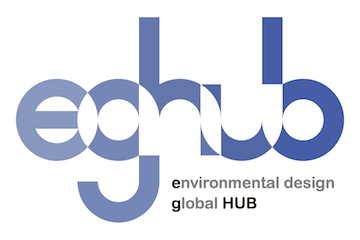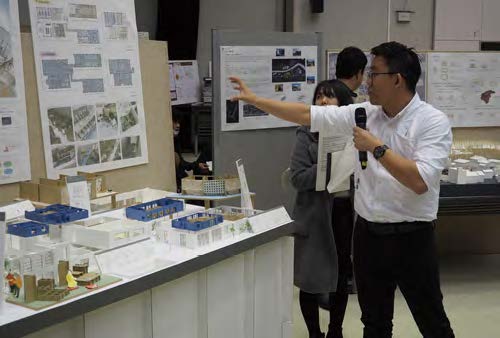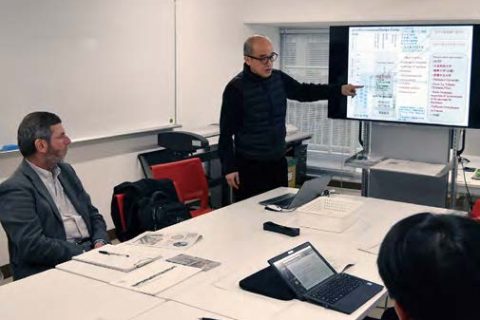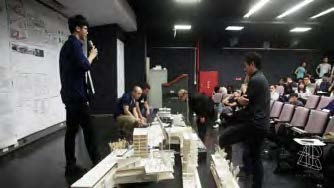Senior project presentations of the Department of Environmental Design was held on Friday, 17 Feb. 2017. In 2016, we had a few guest commenters as a part of the Extended Education Program of Kyushu University. This year, we had 15 foreign guest commenters from six countries.
The final presentation started with the presentation by Kodai Takao, whose project was titled “Fabric ground”. He creates a landscape experience over Tosu railway station and defines new Tosu station as a point of transport.
Dr. Scott Hawken (UNSW, Australia) leaded with praise. “I think your presentation is immensely beautiful. So congratulate you, especially a model which is so energetic and I think it’s really speaking a landscape approach. You remind me of Bernard Tschumi’s work. One thing I want to say is with model’s construction techniques are a part of the concept. The one thing I got from our conversation is different districts. You have some dense districts and you have some large scale districts. If you could have expressed districts in your model, this pieces here rather than have abstract rectangles, you could have shape the different districts. The other thing I really like about your project is the sensitivity to town. This project have the sensitivity to other environmental factors like sounds, noise and perhaps breezes, ventilation etc. Think about express them in the drawings too, because it is really important part of the project situated on top of this railway intersection”.
After Scott’s applause, some of the faculty members pointed out the weak points of his projects for improvement . The second presentation was by Honoka Kawai, whose project was titled, “A reminiscence of a future”. She designed a booklet introducing and supporting a much loved local train broken by an earthquake.
Professor Michael Miur (Sydney University) commented. “First of all, I thank you for seeing (the) fantastic students’ work on the final day. I’d just also like to say that it’s really exciting. I don’t know how other people notice, but these first two projects almost showed two sides of the studio. The muscular, strong, wild, shooting across the landscape (like the previous one), and very soft feminine approach to landscape like this project. And when I looked around the projects, I thought this was just a fantastic project. For I’m not speaking Japanese, it was wonderful to see the project through images, through beautiful hand drawings. So thank you, I have no criticism at all on the project, it is wonderful to tell us stories about the place, and tell us stories through pictures, and to make a mock on a landscape tells A story through very careful understanding of a place. I think it’s wonderful. So many of you (who) teach her know the quality work really well done”.
Eight more presentations followed. And after the presentation by Marina Morishima, whose project titled “Ebb and flow of communication” was a shelter design also related to the earthquake in Kumamoto last year, Mr. Ian Tan (Singapore) commented. “I really like the idea of you studying playrooms and public spaces, especially understanding each person’s needs well. I think environmental design, it’s not just a problem appreciation. I think it’s a lot about appreciating each other’s sound qualities of nature. But environmental design is also some kind of hopping unpleasantness for each other. The shelter design is important for the resilience of people after disaster and how you can have returned dignity back to the people, and I think this project has a lot of potential.
This comment was followed by a more general comment from Ms. Belga’s (UP-Dilman). “It was really difficult to understand all the projects, but there’s still a learning experience for us, since we were coming from different universities. From our university, it’s a different approach. We are giving a rigid standard and parameter for choosing a final research project. So sometimes when students are doing something that they don’t love, their heart is not in there. But what we’ve seen here, these projects are actual ‘passion’ projects, they really like to do. So I think it’s a good reminder for us that design is still personal, and the designer should still find joy in design. Because if we take that out from students, then for example in my experience the students will just go through the process of finishing a project without actually finding joy in their work. And that’s what we have seen here. These are not just the projects of hard work but also liquid of blood. That’s why you see diverse scale projects and we would like to congratulate the faculty (of Design) in Kyushu University for showing us that, and reminding us that it’s more important to inspire our students to continue to design so that they will design not only for themselves but also for other people”.
Other projects are presented as follow,
- Hana Otsu “To pioneer village paths with children”
- Takaki Ito “The suigo architectures, the white shapes by the red”
- Ken Fukuda “Hut of the wedge”
- Tomohiro Maeda “Reverberation corridor, an earth-work on the forgotten soundscape”
- Yuki Ishikawa “Possibility of the space scene change by the viewpoint change”
- Kenta Moriyama “A dormitory as an opportunity” Miyazaki Kyohei “Architecture as a fixture”
After all the presentations and discussions, there were two general comments from the guests and a final word from the director of eghub concluded the event.
General comments by Professor Ar Sohail (Premier University, Bangladesh)
“I am very much impressed with the students’ projects. Sometimes we forget about tradition and history in design. So I thank that the faculty here is giving such kind of direction to the students leading (to) wonderful projects considering tradition and history. I will carry this experience (back) to the country”.
General comments by Dr. Scott Hawken (UNSW)
“It is a real privilege to be here with all of you present here today. It is fascinating to see great spirits and each one of their designs and the originality of them as well. It is a real pleasure. I think it is such a special time for everybody here to see each other’s design and learn from each other. I think that to take this memory of architecture and design, creative education, not to forget this time maybe working with other people makes more challenging. Providing you work as a designer, so many different models offered today. Some people are working very closely with communities, not acts as the top of hierarchy but as the equal player in a range of traits of professions and specializations. Each one of these have different offering collaborative possibilities”.
Final words by Professor Doi (Kyushu University)
“I remember two questions from professors. The first is the passion project. I understand but I do not agree in many respects. Of course our students diverted to choose their subjects which is very good because I think we share these projects as not looking for the solutions but looking at the problems. Finding problems is very important and it will make many projects better. In this case, our students are sometimes capricious and sometimes just lost of course, but we can check this. There is a choice to lead these students in this way, so that they find their problem with their own eyes. And the second question is modernization. They are very important items. In course of the modernization we discover the history. Let’s continue the discussion tomorrow (in the eghub symposium)”.



